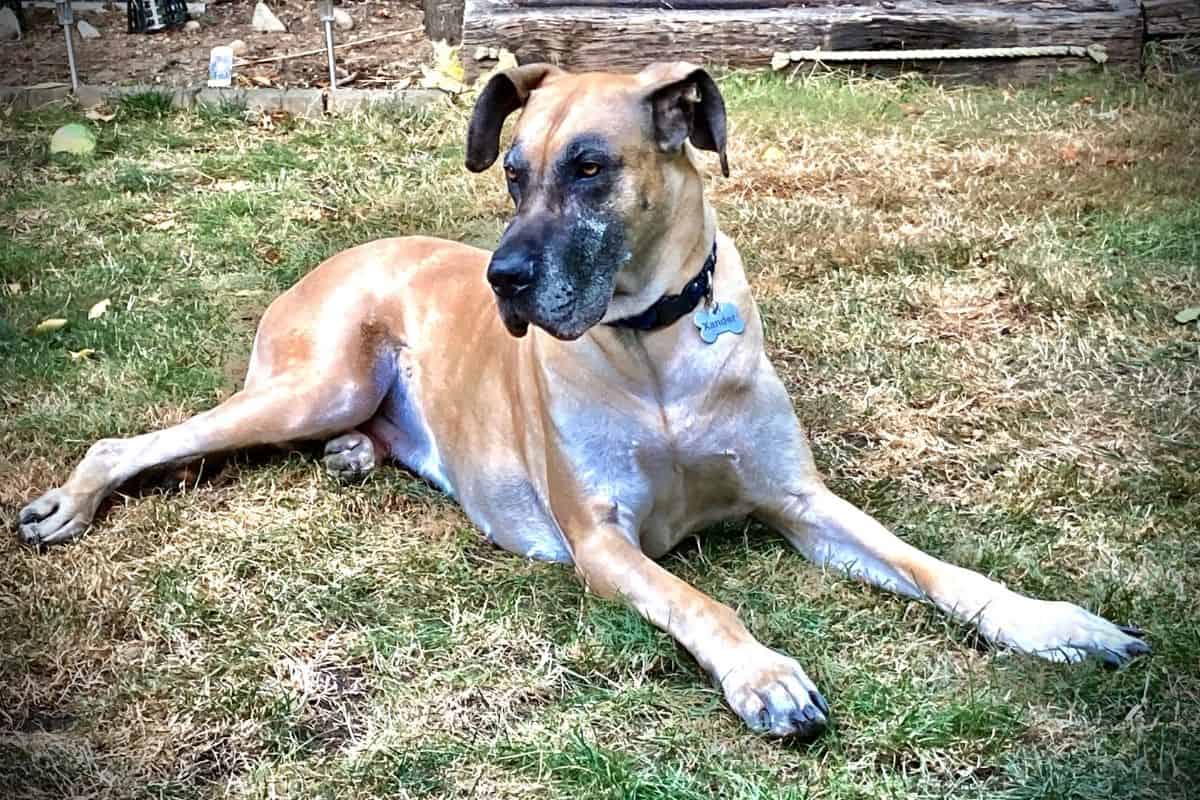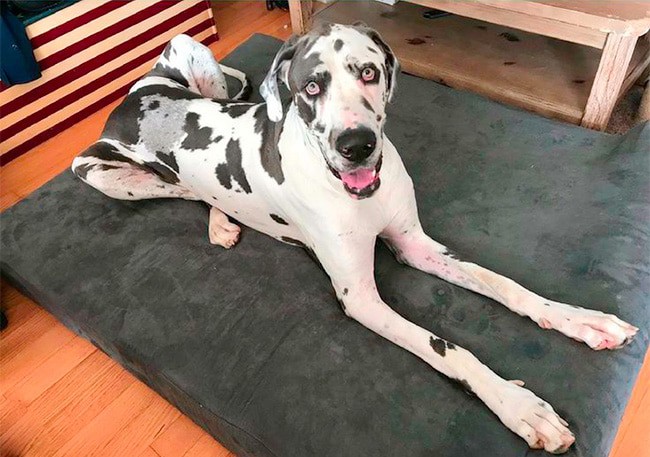
There is nothing quite like welcoming a new puppy into your home. That new puppy, however, will one day become a senior pet.
There are many things we can do for our larger-than-life fur children to help them live their best and most comfortable lives as long as possible!
5 things that you can do to help keep your Great Dane healthy:
- Keep them active
- Provide them comfort
- Stay up to date with Veterinary care
- Provide proper dental care
- Make lifestyle adjustments
What is considered senior for a Great Dane?
A large breed dog such as a Great Dane will have special considerations as they begin to age that differs from smaller breeds.
With the average lifespan of a Great Dane around eight-ten years, compared to their smaller counterparts that live twice as long, it hardly seems fair that these gentle giants get such a short time to spend with us!
Large breed dogs are seniors earlier in life, and some giant breeds like Great Danes start to be considered senior dogs around age 5 or 6 years of age.
By comparison, smaller breeds become senior dogs later in life, about age 7 to 10.
5 Tips for Caring for a Senior Great Dane
Without further ado, let’s take a look at 5 tips to help your aging Great Dane!
1. An active Great Dane is a healthy Great Dane!
Keep your senior Great Dane active! As with older people, keeping older pets mobile through appropriate exercise helps keep them healthier and more mobile.
If they don’t use it, they will lose it!
A few ways to help keep your Great Dane active are:
- Giving your Great Dane Supplements: Vitamin supplements can help keep joints healthy and moving without pain, making exercise easier on the pet. Great Danes need high-quality glucosamine and chondroitin, which can be found in many supplements from your veterinarian or local pet store.
- Keeping them at a healthy weight: Keeping your senior dog active will also help prevent weight gain. Keeping your Great Dane at a healthy weight is the most important thing you can do to help minimize the effects of arthritis.
- Tracking their activity: You can track your dogs’ daily activity levels when you are away from home by using specially designed activity monitors and GPS dog collars. Dog monitors that you can attach to your dog’s collar are useful tools that are designed to help pet parents keep tabs on their dog’s activity level.
If activity levels are low, dog owners can adjust a pet’s exercise routine to include more playtime or longer walks.
If your Great Dane seems to be slowing down, it might be a sign of pain, and you may need a vet visit for some pain or orthopedic medications.

2. Keep your Great Dane comfortable
Invest in a high-quality orthopedic pet bed. Old joints need the extra support provided by a deep cushion.
Sadly, the bodies of your Great Dane contain a flaw; their joints slowly deteriorate under their own weight, and an ordinary, active lifestyle might eventually become impossible.
Providing a thick supportive memory foam orthopedic bed can help take the strain off of the joints and relieve pressure. A good, very high-quality memory foam orthopedic
Providing an orthopedic bed can also help to prevent calluses!
Joint calluses are rough, thick sores that form to protect your Great Dane’s bones from the pressure of lying on the hard surfaces found in your home.
They are most common on the elbows of seniors but may also affect the hips, hocks, sides of the legs, and sternum. The calluses can be itchy, painful, or even lacerate and become infected.
Concrete, tile, and hardwood flooring are the most common culprits in causing calluses. Even dogs who routinely sleep on pads or beds can develop these calluses if the padding is not thick enough.
Regular dog beds can also flatten over time with use, providing even less cushion than a high-quality orthopedic bed would provide.
A quality orthopedic bed may not just mean better sleep, but it could also mean a healthier, more active dog!
3. See your veterinarian
As your Great Dane ages, so do its vaccination needs. Senior pets are typically vaccinated once every three years. Some vaccines that have a shorter duration of immunity should be vaccinated every 6 to 12 months.
Many pet owners often discontinue vaccinations for their senior pets who have had a lifetime of yearly injections. A blood titer test can determine if your Great Dane has enough antibodies to hold off on that specific vaccine.
Annual or bi-annual blood work is recommended for all senior Great Danes. Comprehensive testing is recommended for older pets due to the higher risk of underlying disease.
There are four main things that your vet will want to do at a wellness visit for your Great Dane.
- Complete blood count (CBC): A CBC will check the red blood cell, white blood cell, and platelet counts. It provides details about the number, size, and shape of the various cell types and identifies the presence of any abnormal cells.
- Biochemistry profile: A biochemistry profile is a panel of tests that provides information about the liver and kidney functions, as well as other organs and tissues of the body. It helps to detect diabetes, kidney disease, liver disease, and other disorders.
- Urinalysis: Urinalysis is part of a complete assessment of the kidneys and urinary system and should be included in routine wellness testing. Urinalysis gives your vet information about how well your Great Dane’s kidneys are working and shows any inflammation or infection in the urinary system.
It can also help to detect diabetes and can be useful in the diagnosis of cancer within the urinary system. - Thyroid hormone testing: A thyroid test checks the thyroid gland, which acts as the body’s thermostat and sets the metabolic rate. Dogs are prone to hypothyroidism which occurs when the thyroid gland fails to produce enough thyroid hormone.
Hormone levels should be tested routinely and especially if any weight gain is noticed or your Great Dane becomes more lethargic or develops hair loss of the body or tail.
One of the most common life-threatening diseases Great Danes are prone to is Dilated Cardiomyopathy (DCM). A Great Dane with DCM has a heart that becomes very large, thin, and very weak.
This weak heart can no longer effectively pump blood to the body.
As this problem advances, your Great Dane may show some of these signs:
- Acting weak or tired,
- Faint or collapse,
- Breathe in a labored way, or
- Cough excessively.
DCM condition is treated with medication and supportive care.
Osteosarcoma, Lymphoma or lymphosarcoma, and hemangiosarcoma are the most common types of cancers that occur in large breeds like the Great Danes.
Knowing what signs and symptoms to look out for can help you detect these issues earlier in your Great Dane.
- Osteosarcoma is a very aggressive bone tumor in dogs. Symptoms include swelling, lameness, and leg pain. It is critical to detect this cancer early, as it is likely to metastasize or spread through the body and to the lungs.
Surgical growth removal, amputation, and chemotherapy can help to prolong the life of your beloved pet, but there is no cure. - Lymphoma or lymphosarcoma is common cancer that affects the lymphocytes and lymphoid tissues. The lymphoid tissue is present in many different places in your Great Dane’s body, including the lymph nodes, liver, spleen, gastrointestinal tract, and bone marrow.
The most common symptom of Lymphoma or lymphosarcoma is swollen and painful lymph nodes. Lymphoma is a very treatable type of cancer. Great Danes that receive chemotherapy usually have a good success rate, but the treatment can be costly and is often a lifelong commitment.
Luckily, Lymphoma is one of a few types of cancer that can easily be found with a blood test, so it is recommended that you have a complete blood count done twice yearly. - Hemangiosarcoma is a bleeding tumor often found in the spleen and other organs. These tumors can grow very large and will often break open and cause internal bleeding unbeknownst to the owner. Routine blood testing and ultrasound can help diagnose a hemangiosarcoma.

4. Don’t neglect dental care!
Although bigger dogs (like Great Danes) generally have fewer dental problems throughout their lifetime than smaller dogs, dental hygiene is still a very important aspect of their care!
Aging dogs are at increased risk for gum disease and cracked teeth, which require veterinary attention and can be very painful. Gum disease leads to bleeding gums, which can allow harmful bacteria from the mouth direct access to the heart by way of the bloodstream.
Gingival hyperplasia is also fairly common with large breed dogs like Great Danes. Gingival hyperplasia is an overgrowth of the gum tissue and can be removed during a dental prophy cleaning.
Brushing your senior Great Danes chompers is the gold standard in dental care, but routine dental cleanings are highly recommended. Daily home dental care is also helpful to help mechanically remove dental calculus from the teeth.
Using enzymatic treats or coated dog food, dental rinses, and barrier gels can help to prolong the time between normal dental cleanings.
Radiographs during a dental procedure can help locate and diagnose dental problems unseen above the gumline.
5. Make lifestyle adjustments
As your Great Dane ages, simple changes around your home can help them get around without help.
These are some things that you can do to help your Great Dane get around your house easier.
- Use dog shoes: Some Great Danes will have trouble getting up from a down position, especially on hardwood or tile floors. Using rubber-soled dog boots can help them gain the friction they need for their feet not to slip out from under them.
- Put Rugs around your house: Placing a rug on a slippery floor and in common places can also be beneficial for an aging Great Danes.
- Use a sling to help them walk: Using a sling or a towel under their hips can help get an arthritic Great Dane outside for some time in nature.
If your Great Dane starts to have problems with vision, it’s best not to rearrange the living room. It is amazing how well they can navigate in familiar territory, even when blind.
Finally, the most important thing to remember is to spend special time together, even if it’s just cuddling on the couch. Great Danes are especially good cuddlers, and time together is what a happy senior dog will cherish most.
We have a limited time to enjoy a unique and special relationship. Keeping your gentle giant happy, comfortable, and cared for by your veterinarian and in familiar territory is a very simple thing for us to deliver. Savor each moment you have with your aging Great Dane!
They will take up a huge space in your heart in a relatively short time!

How is gus? I follow her on youtube.. haven’t seen her in a while! Hope all is well with her (and you and your family as well). We need an update!
Gus and family are doing great, thanks for checking!
At what age should the routine blood tests start? Our baby is just turning 1.
I was surprised to see those Virbac dental treats on the list! They are basically beef rawhides and in everything I have ever read those are the worse things for ANY dogs. Can you elaborate on this? How can they be safe?